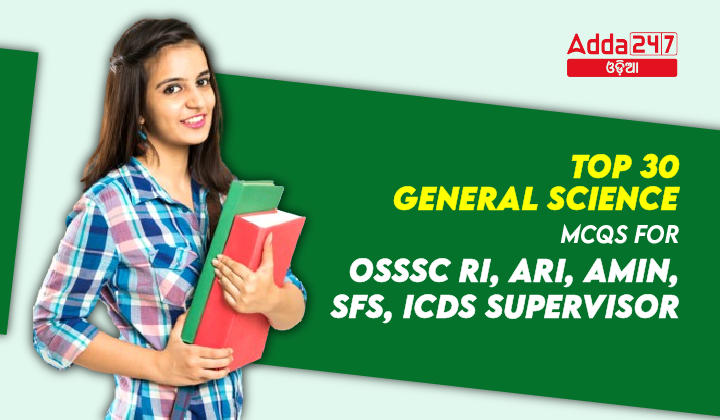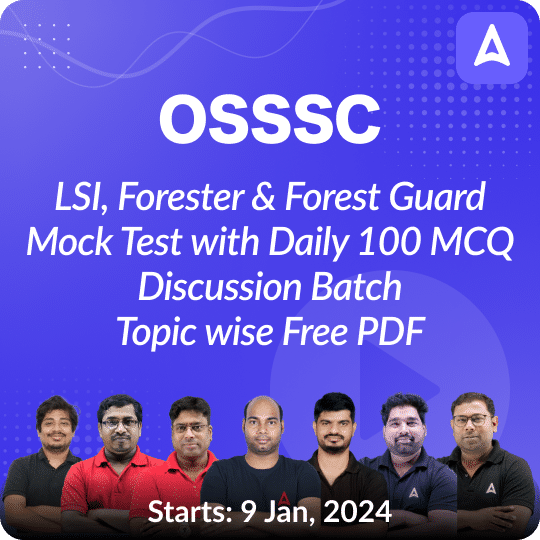General Science forms an essential part of many competitive exams in India, including those conducted by the Odisha Sub-ordinate Staff Selection Commission (OSSSC) for various positions like Revenue Inspector (RI), Assistant Revenue Inspector (ARI), Amin, Senior Food Security Officer (SFS), and ICDS Supervisor. To excel in these exams, candidates must have a strong grasp of fundamental scientific concepts. Here, we present the top 30 General Science multiple-choice questions (MCQs) to help candidates prepare effectively.
Top 30 General Science in India MCQS For OSSSC RI,ARI, Amin, SFS, ICDS Supervisor
- What is recognized as the earliest calculating device?
A. Abacus
B. Calculator
C. Turing Machine
D. Pascaline
Answer: A - Who developed the mechanical calculator known as Pascaline?
A. Charles Babbage
B. Blaise Pascal
C. Alan Turing
D. Lee De Forest
Answer: B - Who is often referred to as the ‘father of artificial intelligence’?
A. Charles Babbage
B. Lee De Forest
C. John McCarthy
D. JP Eckert
Answer: C - Which was the world’s first successful electronic computer?
A. PARAM
B. CRAY-1
C. Pascaline
D. ENIAC (Electronic Numerical Integrator and Computer)
Answer: D - Who coined the term “computer worm”?
A. John Brunner
B. Alan Turing
C. John McCarthy
D. JP Eckert
Answer: A - What was the first virus detected on ARPANET, the precursor to the internet in the early 1970s?
A. Exe File
B. Creeper Virus
C. Peeper Virus
D. Trojan Horse
Answer: B - What is the correct definition of Wide Area Network (WAN)?
A. It is a programming language with strong abstraction from the details of the computer.
B. It is a collection of computers interconnected with each other through cables to share their data, information, and other common hardware resources.
C. A computer network that covers a broad area (i.e., any network, whose communications links cross metropolitan, regional, or national boundaries).
D. A computer network covering a small physical area like a home, office, or small groups of buildings, such as a school or an airport.
Answer: C - Which of the following is an example of application software for computers?
A. Ms Word
B. Ms Excel
C. Both A and B
D. MS-DOS
Answer: C - What is another term for a translator?
A. Data representation
B. MS-DOS
C. Operating System
D. Language Processor
Answer: D - How is the quality of a printer measured?
A. Alphabet per strike
B. Words per Inch
C. Strike per Inch
D. Dots per Inch
Answer: D - What is Anatomy primarily concerned with?
A. Structure of animals and plants
B. Functioning of body organs
C. Animal behaviour
D. Cells and tissues
Answer: A - What is Oncology the study of?
A. Birds
B. Cancer
C. Mammals
D. Soil
Answer: B - What does Numismatics study?
A. Coins
B. Numbers
C. Stamps
D. Space
Answer: A - What does Eugenics focus on?
A. Different races of mankind
B. Genetics of plants
C. People of European region
D. Altering human beings by changing their genetic components
Answer: D - What does Ornithology deal with?
A. Study of plants
B. Study of bones
C. Study of noise
D. Study of birds
Answer: D - Epidemiology is primarily concerned with:
A. Endodermis disease
B. Dermis disease
C. Epidemic disease
D. None of the above
Answer: C - In what unit is the energy of food measured?
A. Calories
B. Celsius
C. Kelvin
D. None of the above
Answer: A - What instrument is used to measure Relative Humidity?
A. Hygrometer
B. Hydrometer
C. Barometer
D. Mercury Thermometer
Answer: A - Which instrument is used to measure the Density of milk?
A. Lactometer
B. Hydrometer
C. Barometer
D. Hygrometer
Answer: A - Which instrument is used to measure electric resistance?
A. Ohmmeter
B. Electrometer
C. Galvanometer
D. Spectrometer
Answer: A - What instrument is used to measure the intensity of earthquakes?
A. Richter Scale
B. Ammeter
C. Hyetometer
D. Oometer
Answer: A - What does a fathometer measure?
A. Earthquakes
B. Rainfall
C. Ocean depth
D. Sound intensity
Answer: C - What is the purpose of a coronagraph?
A. Study the veins
B. Studying Blood Pressure
C. Studying the arteries
D. Observing and often photographing the sun’s corona.
Answer: D - Define Aerodynamics:
A. It is a science of movement in a flow of air or gas.
B. It is a science of generative organs.
C. It is a science of pleasure and pain.
D. None of the above
Answer: A - What does Bryology study?
A. Study of food
B. Study of fruit
C. Study of mosses and liverworts
D. Study of rings
Answer: C - What does Chirology study?
A. Hands
B. Feet
C. Comets
D. Skull
Answer: A - What does Entozoology study?
A. Enigmas
B. Glands
C. Enzymes
D. Parasites that live inside larger organisms.
Answer: D - What is the study of increasing the habitability of the earth called?
A. Geology
B. Geotechnics
C. Geoponics
D. Geogony
Answer: B - Thalassography is the science of:
A. Sea
B. Animal tissues
C. Humidity
D. Measuring heights
Answer: A - What does Topology study?
A. It is the study of places and natural features.
B. Study of hair and its disorders.
C. It is the study of shape and features of the moon.
D. Study of theological salvation.
Answer: A





